Lesson 3-How a horoscope is cast and the four types of chart styles.
Before learning about the other aspects of astrology, you must now learn about how a horoscope is cast and how to read it. We are not going into the teaching of the complicated mathematical aspects of calculating the planetary positions, lagna etc. Now a days even the astrologers depend on the computerised software. From the practical point of view of learning the basics, you only need to know how the birth chart is cast and how to read and understand it.
The horoscope is the picture of the heavens at the time of ones birth. It shows in which rasis, or signs, the 9 planets are positioned. It also shows another important aspect of astrology called the Lagna or the Ascendant. It plays a major role in analyzing an individuals life. The ascendant is calculated based on your place and time of birth and varies from place to place. This is because of the difference in latitude and longitude and the sun rise time. Lagna is called your individual 1st house. It must be noted that the lagna may fall in any of the 12 rasis. The counting of your individual houses is always done from the lagna. You will learn about the houses and their importance in the next lesson.
The position of the planets on any given day and time is calculated from the ephemeris, called Panchang, and the horoscopes are made accordingly. It is not some kind of a mystic charting of planetary names in a chart.
Difference in measuring the planetary positions – Vedic vs. Western astrology
Vedic Astrology follows the Niryana or the sidereal zodiac, where as the Western Astrology follows the Sayana or the tropical zodiac. Its a highly complicated astronomical subject. Briefly the fundamentals are as follows.
The placement and especially the degrees of the planets in the birth chart of a person made according to western astrology differ considerably from the birth chart made according to Indian astrology. According to the western sun signs Sun enters Aries on 21st of March but according to our calculations it enters Aries on the 14th of April. So there is a 24 degrees difference. The Western or “Sayana” zodiac system makes calculations and predictions based on the present position of the planets from a zodiacal point of view or AS OBSERVED BY THE SATELLITES.
Our system is called “Nirayana” or Indian System. In the Nirayana system, the planetary positions are AS SEEN FROM EARTH TODAY by taking into account the tilting of the North pole by making corrections accordingly.
If you take the standard globe available in the market and keep it on the table, you will observe that the North and the south poles are not exactly 90 degrees vertically up but are tilting. This inclination is about 23+ degrees to the east and it greatly effects astronomical calculations. See the picture.
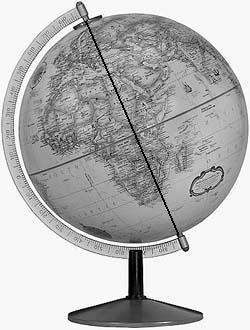
This inclination is caused due to the shifting of the vernal equinox, which happens because of the West to East spin of the earth around its axis. While playing tennis or table tennis, if you give a sideways spin to the ball it not only spins in the direction of the spin but also swerves or swings in the air. Similarly as the earth is spinning towards the east on its axis, the North Pole is slowly tilting towards the east. This difference between the longitudes of the starting points of the sidereal and tropical zodiacs is called Ayanamsha. The starting points of the sidereal and tropical zodiacs coincides once in every 25,800 years approximately. According to accurate scientific calculations, the present shift started in the year 285 AD, i.e. 285 years ago the North Pole was perfectly vertical at 90 degrees. The most accurate method of calculating this ayanamsa is the Chitrapaksha ayanamsa, popularly called Lahiri Ayanamsa.
The ayanamsa calculations of the Greeks like Hippocras and Ptolemy were wrong. The western scientists are officially “credited” with the “discovery” of the accurate shifting of the earths equinox towards the end of the 19th century. They found it to be 50″. It was actually known to the Hindu astrologers long before that. Varahamihira, the famous astrologer in the court of Vikramaditya in the year 57BC, clearly mentioned in his work Pancha Siddhantika, based on our ancient Siddhantas, that the ayanamsa is 50.32 seconds. This is the most accurate one.
The difference between the Sayana longitudes and the Nirayana longitudes of Planets is called “Ayanamsa” or precision. This Ayanamsa difference is the exactly calculated shift or inclination of the equinox. For example on this day on 23rd June 08, the exact Ayanamsa or the tilt is 23:58:43 degrees. From the longitude poison of the planets in the Zodiac at this moment, when this Ayanamsa is deducted, we get the correct longitude of the planets as applicable to our position on earth. In the western system as this shift of the equinox is not taken into account, all the planets are about 24 degrees ahead. The picture given bellow will give you an idea.

The position earth shown at the bottom in the picture is with equinox tilted correctly i.e. corrected Ayanamsa. If you are born on the dark spot see the position difference of Sun if Ayanamsa is not corrected. We are more concerned as to where the planet is vis-à-vis our position on earth and not as seen by a satellite! And we definitely don’t follow the equinox position of 285AD !!
The four types of charting styles.
In India the astrologers follow different methods of casting a chart. There are mainly four methods of casting the charts. They are explained bellow.
South Indian method: In the south Indian style of casting a chart, the position of the zodiacal signs, from Aries to Pisces always remains fixed, as shown in the picture below left. The counting of the houses and the positioning of the planets is done clockwise, as shown in the picture below right. This changes from individual chart to chart. So it can be said that the south style chart follows the fixed sign method. The sign which becomes the ascendant or lagna is marked with the words As or Asc or Lagna. In some cases astrologers also draw two parallel lines at the top corner of the ascendant, the way we cross a bank cheque, to mark the ascendant
The South Indian Style
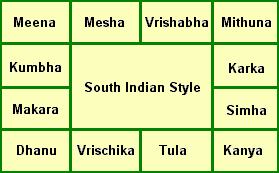
The data given in the table to the right below, shows the ascendant and the 9 planets in the 1st column, their exact degrees in the 2nd column, the rasi in which they are placed in the third column, the nakshatra in which they are placed in the 4th column and the nakshatra pada in the last column. The birth chart is made placing the planets in those houses. The positioning of the planets and the ascendant is as follows.
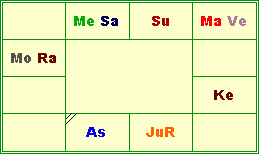
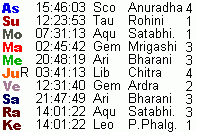
Ascendant or Lagna: In Vrischika or Scorpio
Sun : In Vrishabha or Taurus
Moon: In Kumbha or Aquarius
Mars: In Mithuna or Gemini
Mercury: In Mesha or Aries
Jupiter: In Tula or Libra
Venus: In Mithuna or Gemini
Saturn: In Mesha or Aries
Rahu: In Kumbha or Aquarius
Ketu: In Simha or Leo
Please note:
The sign in which the moon is placed is called Janma Rasi or moon sign. In this case the janma rasi is Kumbha or Aquarius.
The nakshatra in which the moon is placed in the birth chart in called Janma Nakshatra. In this case the janma nakshatra is Satabhistha 1st quarter.
As obvious in this chart the lagna is Vrischika, moon and rahu are in the 4th house counted from lagna, Mercury and Saturn are in the 6th house from lagna, Sun is in the 7th house, Mars and Venus are in the 8th house, Ketu is in the 10th house and Jupiter is in the 12th house.
North Indian Style
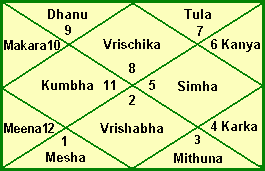
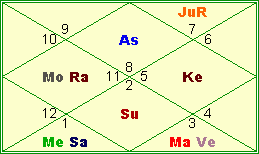
North Indian method: In the north Indian method of casting the chart, as in the above example, the ascendant or lagna is always kept at the top center and the signs are denoted by their zodiacal sequence number, i.e., Aries is 1, Taurus is 2, Gemini 3, Cancer 4, Leo 5, Virgo 6, Libra 7, Scorpio 8, Sagittarius 9, Capricorn 10, Aquarius 11 and Pisces 12. Here the charting of the houses and the planets is anti-clockwise. In the above demonstration the same chart with the same planetary positions is shown. The lagna is Vrischika and denoted by the sign number 8 and placed at the top center. The planets are placed in the same houses, but charted in the anti-clockwise fashion. For example sun is in Vrishabha or Taurus which is the zodiac house number 2. So we can say that the northern chart chart follows the fixed house method.
East Indian or Maithili method: This type of chart, which is popular in Andhra Pradesh and parts of Orissa and Bengal, is drawn differently and follows the fixed sign method of the south style chart, but the charting is done anti-clockwise as shown in the picture bellow.
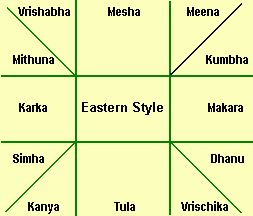
East Indian chart
The circular chart: It is the same as the northern chart in every respect but drawn in a circular fashion as shown below.
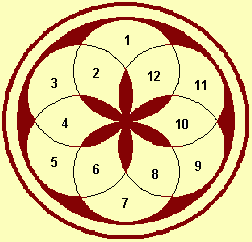
Circular chart









realy gud one..
ReplyDeletePretty good post. I just came across your site and wanted to say that I have truly loved reading through your blog posts.
ReplyDeleteRegards
Astrology Signs
thnx :)
ReplyDeletewelcome :)
ReplyDeleteThanks admin for sharing this informative details with us. It can be great if added more information about best astrologer in kolkata or what kind of astrologer uses in their services.
ReplyDeleteVery beautifull blog post,Thank you
ReplyDeletevisit our website
Vashikaran Astrologer in Chikkaballapur
Thank you for sharing this blog, it is really very good.
ReplyDeleteBest Astrologer in Bangalore
This Blog is really great.
ReplyDeleteBest Astrologer in Bangalore
Such a amazing blog post,Thank you.
ReplyDeletefor any astrological services contact
Best Astrologer in Srinagar